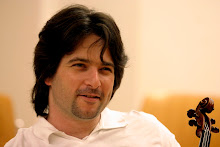So you learned and successfully performed the concerto/sonata/caprices etc but now you have two months before you need to play it again. It is a dangerous phase; playing the piece too much could deteriorate your level but practicing the piece in details every day would keep from learning new pieces, could dull your musicality and is simply boring. On the other hand, practicing the piece too little (or not at all) is not wise when another performance is looming, especially if you are not an experience performer.
When I practice in "maintenance mode" I go over the piece every few days, or even every day, but each time I approach the piece/movement/ passage from one of the different aspects listed bellow.
Intonation - playing slowly and repeating every shift several times, trying to be as aware as possible towards the target note and avoiding relying on motion memory.
Sound - using the Beam of Light method (which I explained in previous entry) I try to play with the cleanest, most attractive sound I could produce.
Technique – there are some passages that needs constant technical work. It could be difficult spots or certain techniques (such as up-bow staccato or trills). In these instances I practice as if I never played the passage before.
Re-learning by heart – one of the nastiest traps we fall into is when we rely too much on motion or music memory when we learn stuff by heart. If we suddenly "get stuck" after forgetting one note or lose our place it is a good indication that we rely too much on knowing the tune or "finger memory". There is also the terrible moment when we doubt every move we make and every note we play. It is a very common phenomenon. To strengthen my note-to-note knowledge as well as detect the weakest links, I practice the passage by heart at least 50% of the tempo, using staccato on the slurs (but keeping the original bowings). I finger each note at a time before I play it and if possible say to myself the name of the note. It is important not to "spill" into playing the piece slowly and relying on the tune. This is a very difficult practicing technique but also a very effective one.
Musicality – It is always good to innovate and try and find new angle to your musical output. As a practice method I play the passage at least once in a complete opposite musicality than the one I usually do. Most of the time it helps re strengthens my resolve about my old decisions but sometimes I find interesting ideas to play with…
Performance – All of the aspects listed above are good and true but sometimes you just need to pick up that fiddle and play the damn thing through without looking back or sideways. It helps if you record yourself and listen back. Try and have a "performance feeling" during this kind of practice. Do not move about the room or stop for any reason as you will not do this on stage.
The list above covers most of the things you want to keep and strengthen but it is not complete and also should not only be restricted to maintenance practice (you can work on it before).
Subscribe to:
Post Comments (Atom)

1 comment:
Wow Mr. Kless, I find many of the posts (I read back some of them) very helpful and interesting.
Thank you very much!
Post a Comment